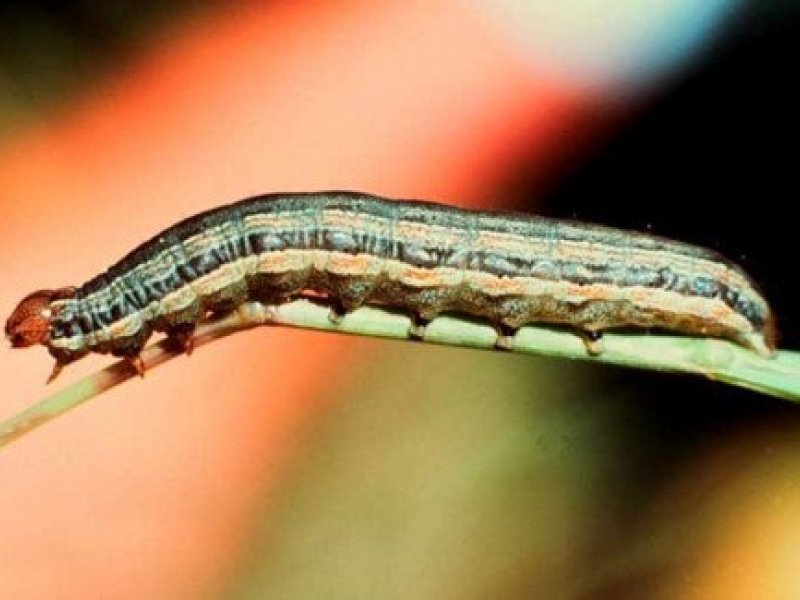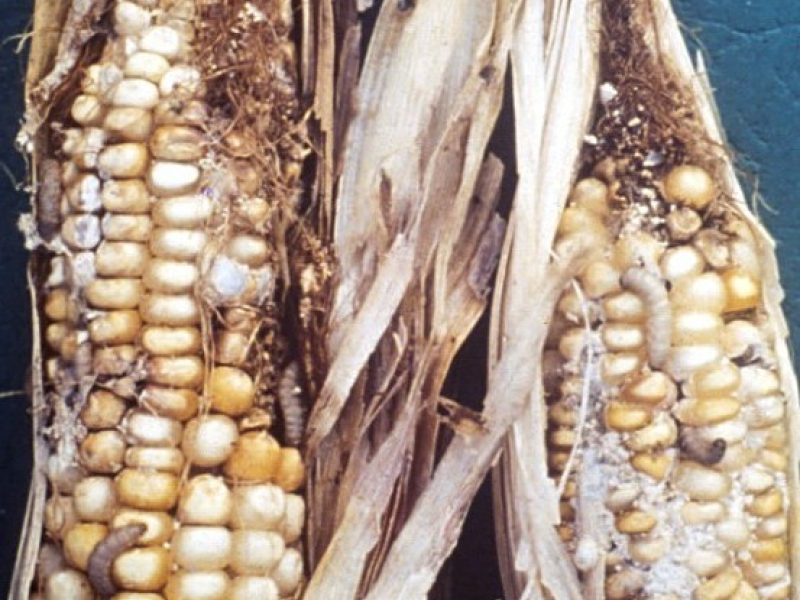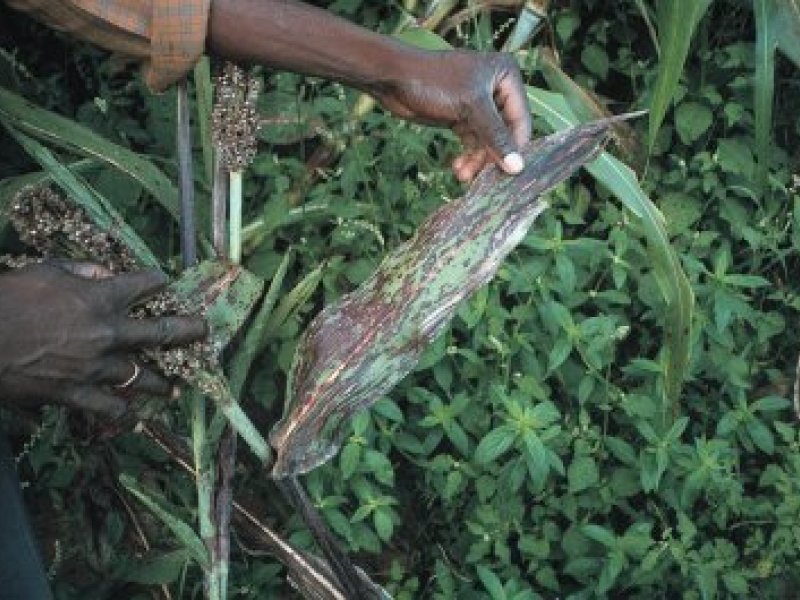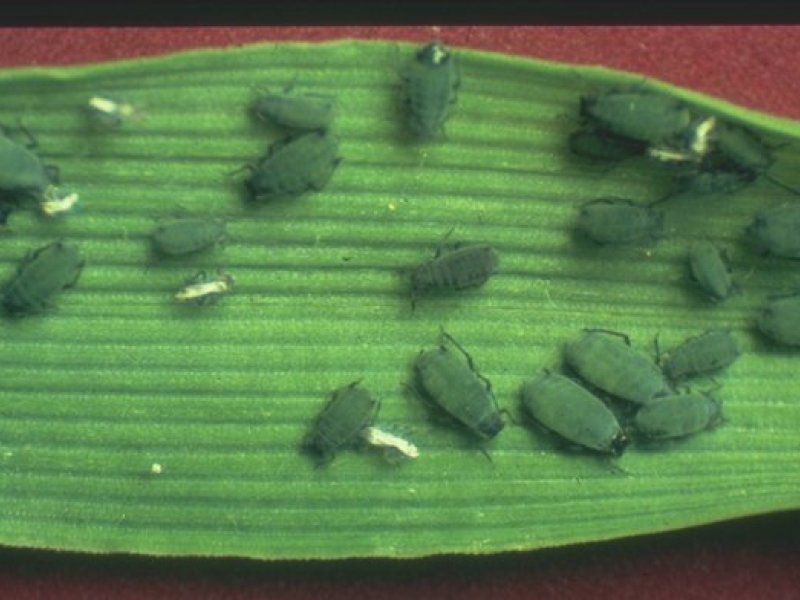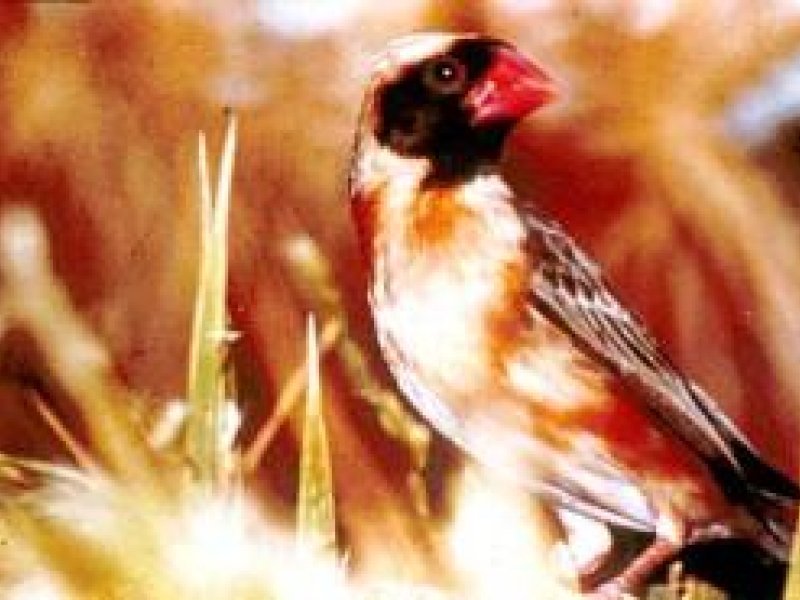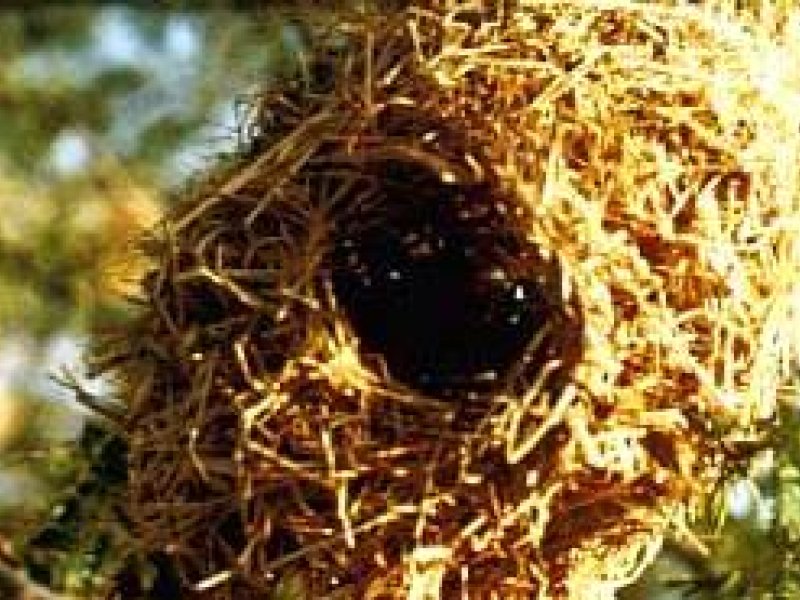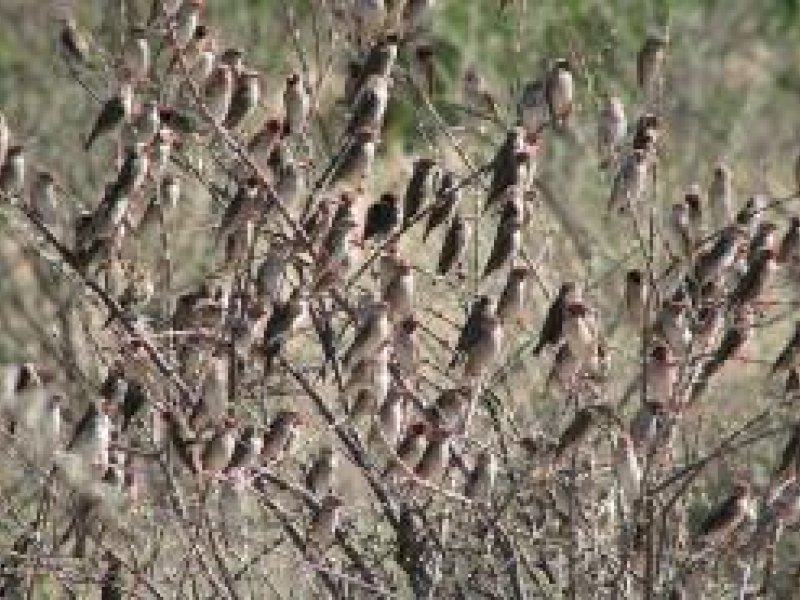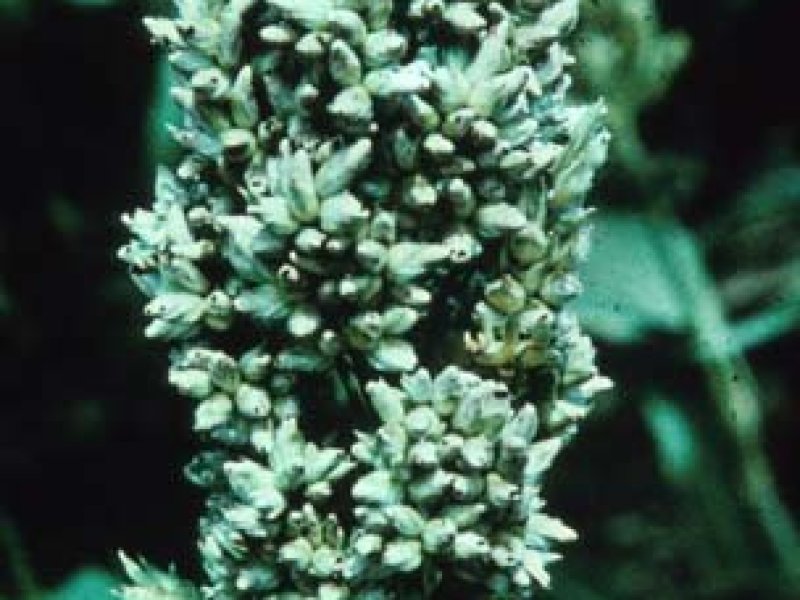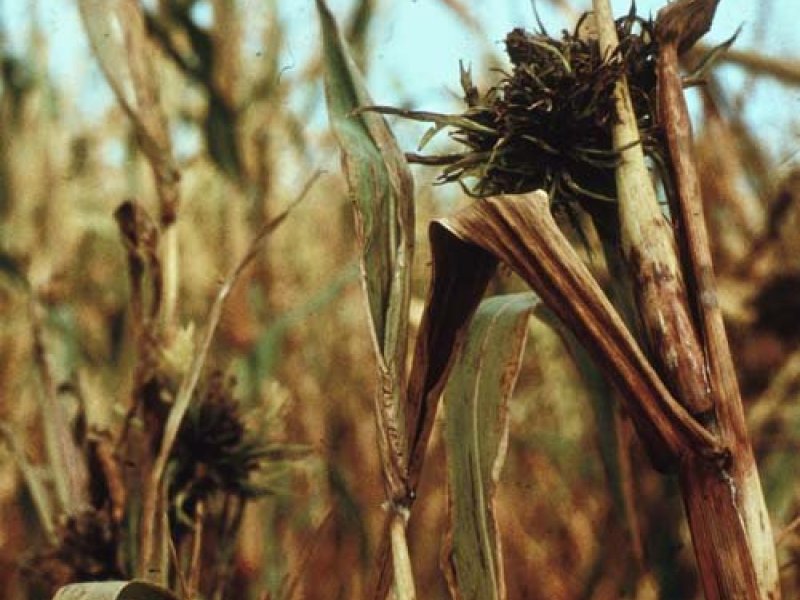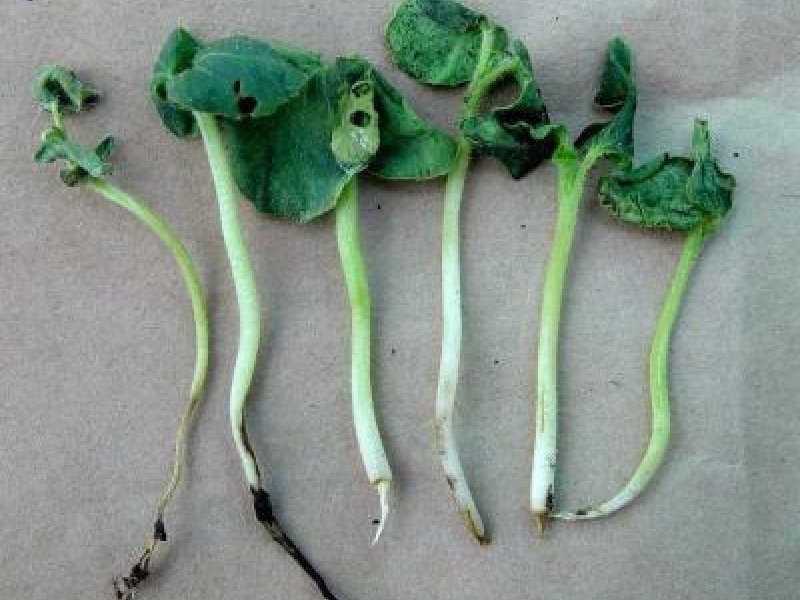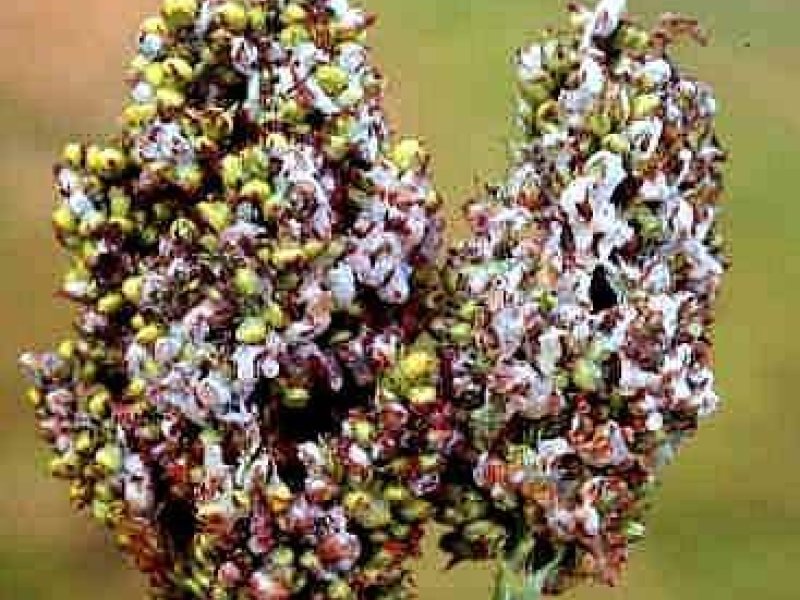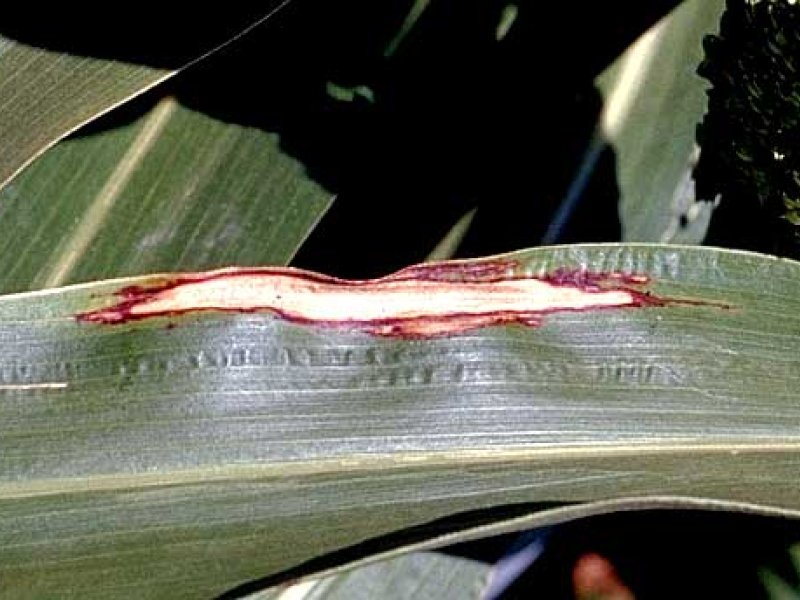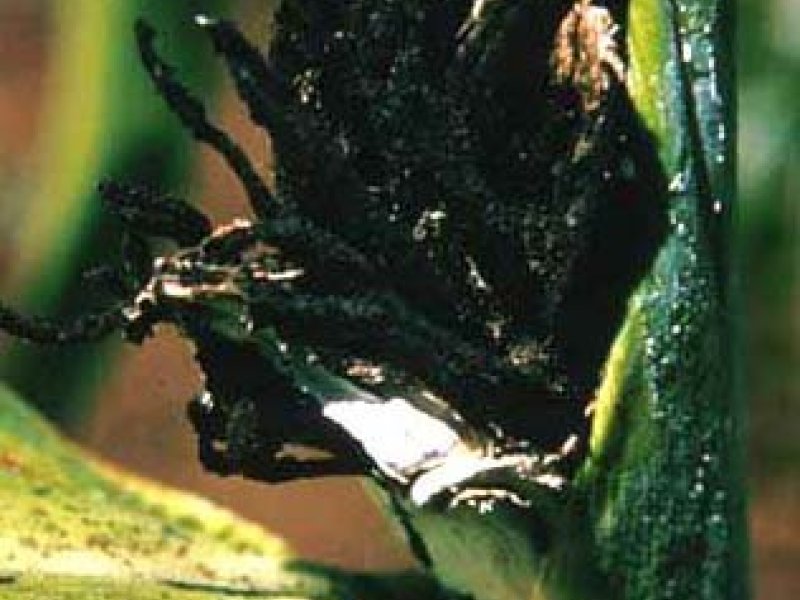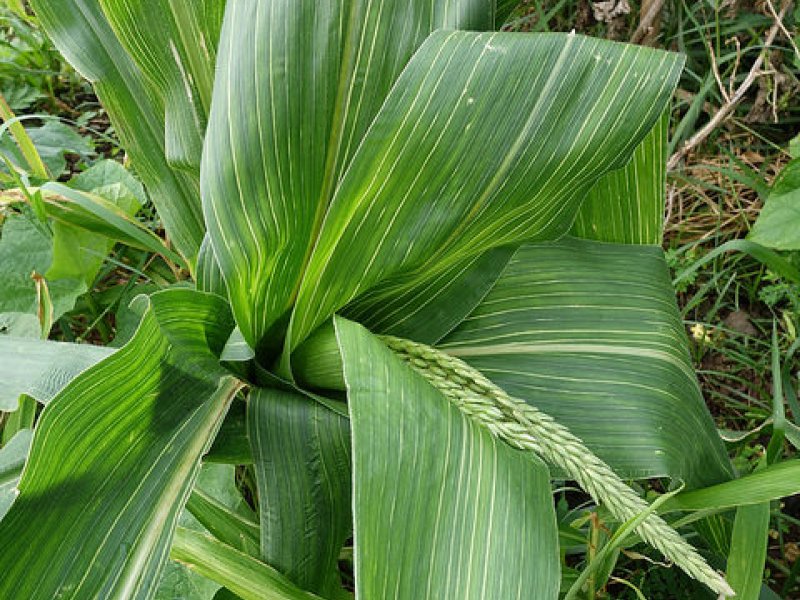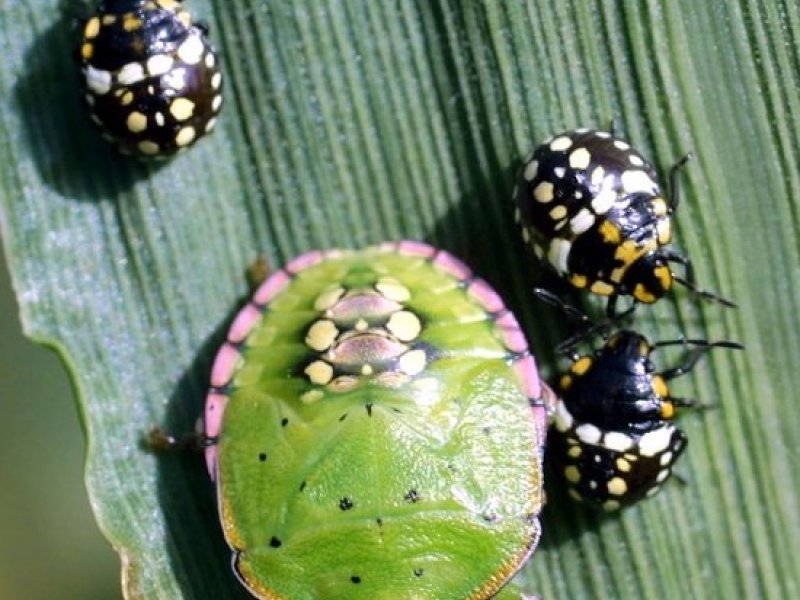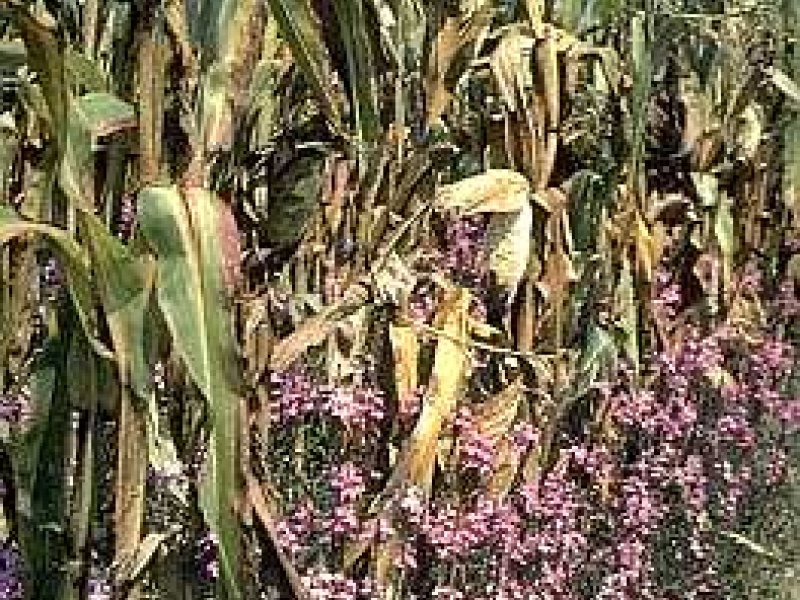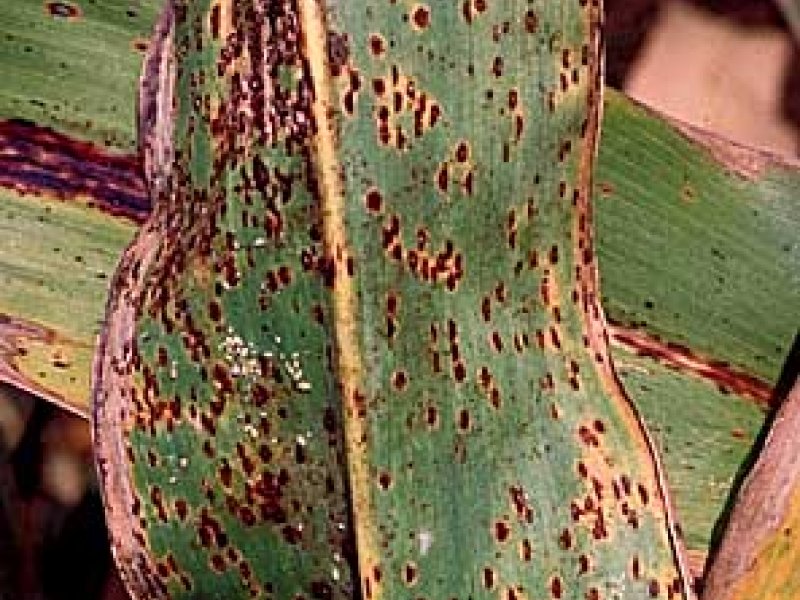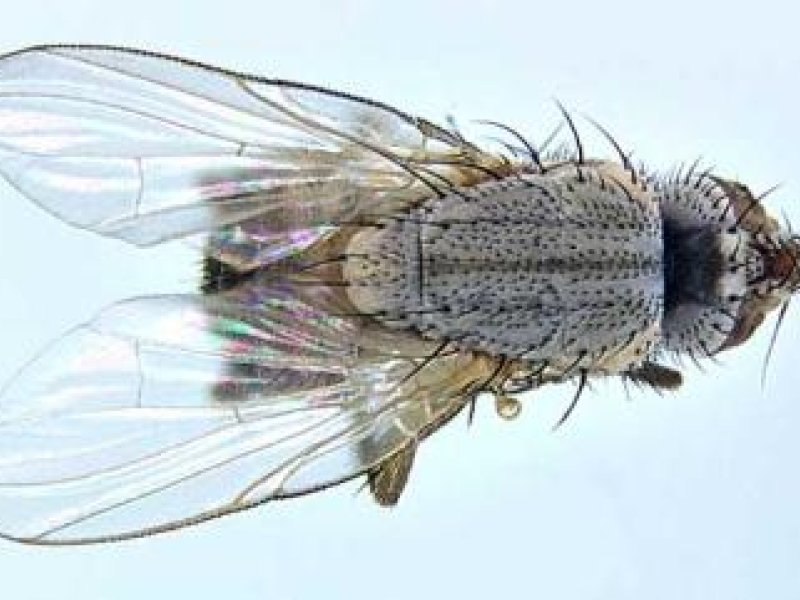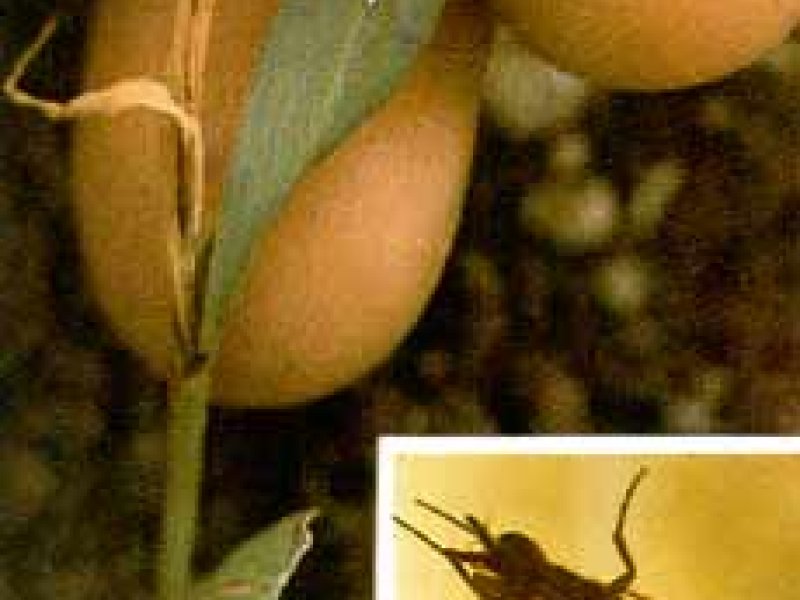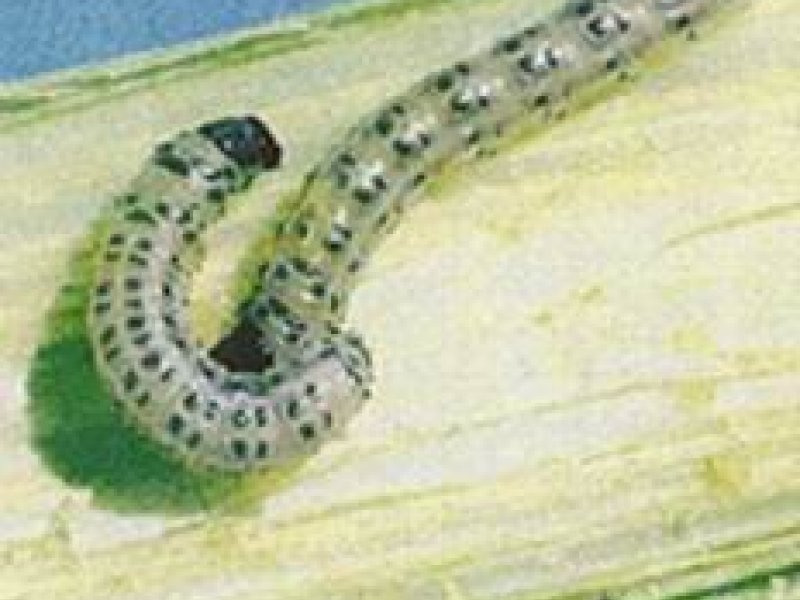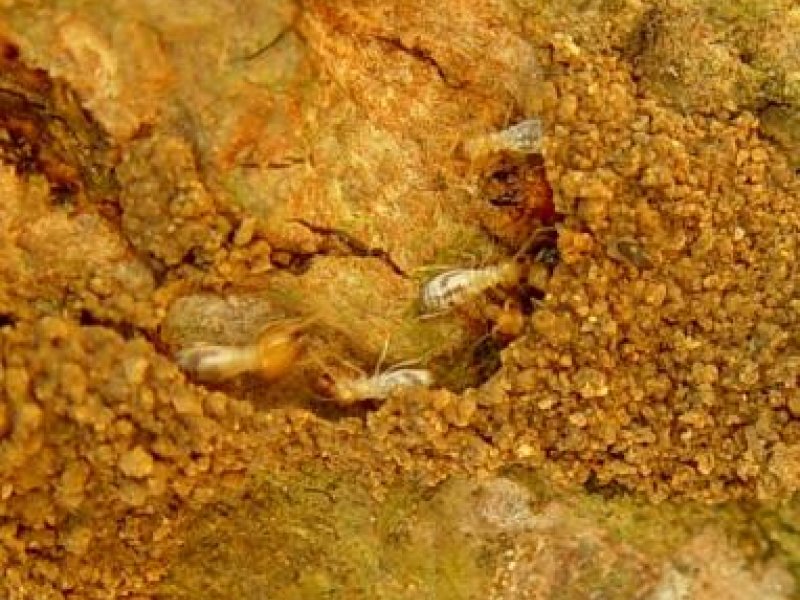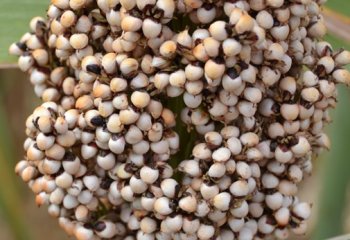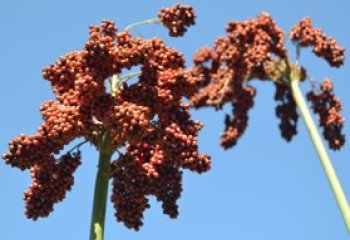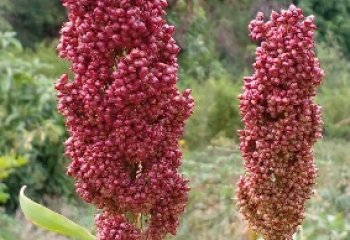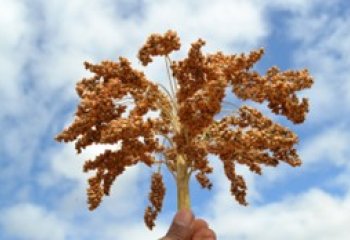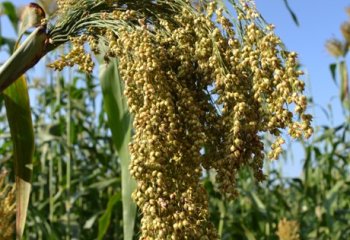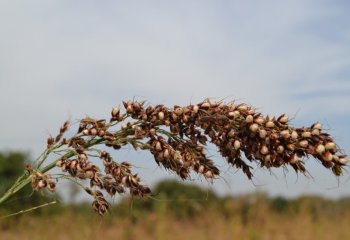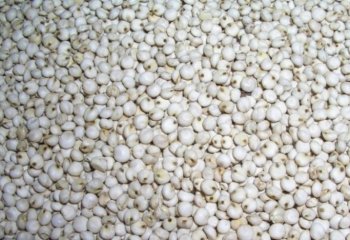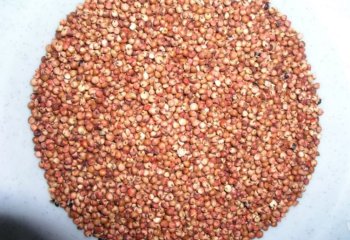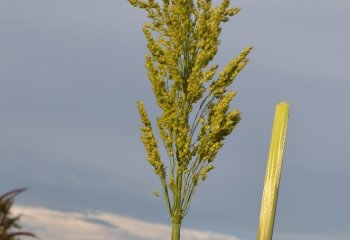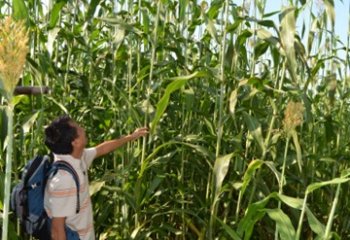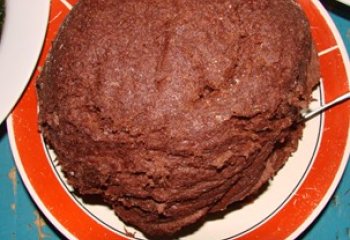|
African armyworm (Spodoptera exempta) It is an occasional but seriously destructive pest. It causes serious damage to young plants in years of armyworm outbreaks. The leaves are eaten away often leaving only the base of the stem. |
|
|
What to do:
|
|
African bollworm (Helicoverpa armigera) It causes damage to sorghum by eating the seeds. Damage is particular serious on compact headed sorghums. The caterpillars appear on the ear heads when the grains are in the milk ripe stage. These caterpillars also feed on whorl leaves. A heavy infestation can cause an almost complete loss of yield. |
|
|
What to do:
|
|
Stemborers: African maize stalkborer (Busseola fusca) Stemborers are the most important insect pests of maize in sub-Saharan Africa. Yield losses vary between 10-70%. Several species have been reported. The importance of a species varies between regions, within a country or even the same eco-region of neighbouring countries. At least four species attack maize in eastern and southern Africa, with yield losses reported to vary from 20 to 40%, depending on agroecological conditions, crop cultivars, agronomic practices and intensity of infestation.
The most important are the African maize stalkborer (Busseola fusca) and the spotted stemborer (Chilo partellus) (see also below).
The pink stalkborer (Sesamia calamistis) and the sugarcane stalkborer (Eldana saccharina) are of minor importance in maize.
Early warning signs: Young plants have pinholes in straight lines across the newest leaves. This is the time to treat - before the caterpillars move into the stem. |
|
|
What to do:
|
|
Anthracnose (Colletotrichum graminicola) The anthracnose fungus damages foliage and stems of grain sorghum. On susceptible hybrids, the stem holding the head (peduncle) becomes infected and a brown sunken area with distinct margins develops. When infected stems are cut lengthwise with a knife, one can see that the fungus has penetrated the soft pith tissue and caused brick-red discolourations. This peduncle infection inhibits the flow of water and nutrients to the grain causing poor grain development.
The fungus also invades individual grains and the small branches of the panicle. Rapid and severe yield loss can result from panicle and peduncle infections. Leaf lesions are small, elliptical to circular, usually less than 0.9 cm in diameter. These spots develop small, circular, straw-coloured centres with wide margins that may vary in colour from reddish to tan to blackish purple. The spots may coalesce to form larger areas of infected tissue. |
|
|
What to do:
|
|
The sorghum aphid (Melanaphis saccari) and the maize aphid (Rhopalosiphum maidis) These are common on sorghum. The sorghum aphid is light yellow in colour, and the maize aphid is dark green to bluish-green in colour. These aphids are often found sucking on ear heads or on the underside of leaves. They produce large quantities of honeydew, which enable black sooty moulds to grow. Attacked plants sometimes are stunted, leaves dry up and yield is reduced. Young plants suffering from drought stress may be killed. Aphids can be a problem during dry periods. Heavy aphid infestations on sorghum at the booting and heading stages seriously reduce both grain quality and yield. The maize aphid transmits the maize dwarf mosaic virus to sorghum. Adults are small, 1-4 mm long, soft-bodied insects. |
|
|
What to do:
|
|
Birds Birds are one of the most important pests of sorghum. They are capable of causing heavy losses. In Africa the most notorious species is Quelea quelea and is found in the Sahel region, from Senegal in West Africa through to Sudan, Uganda, Kenya, Southern Tanzania, Malawi, Zambia and South Africa. |
|
|
What to do:
|
|
Charcoal rot (Macrophomina phaseolina) Grain sorghum plants affected by the charcoal rot fungus fail to fill grain properly and may lodge in the latter part of the season. Infected stalks show an internal shredding at and above the ground line. This can be observed by splitting the stalk and noting the deteriorated soft pith tissue leaving the tougher vascular strands. Fungal structures (sclerotia) can be observed in the affected tissue, which appears as though it has been dusted with black pepper. Another type of stalk rot (Pythium sp. and Fusarium sp.) may show the shredded condition but the black specks (sclerotia) will be lacking.
Conditions under which charcoal rot is favoured include stressful hot soil temperatures and low soil moisture during the post-flowering period. Host plants are usually in the early-milk to late-dough stage when infection occurs. The fungus is common and widely distributed in nature. |
|
|
What to do:
|
|
Covered kernel smut (Sporisorium sorghi) The disease destroys all kernels in a head and replaces them with a cone-shaped gall or may affect only portions of a panicle. At harvest time, these galls are broken and spores contaminate the outer surface of other kernels. |
|
|
What to do:
|
|
Crazy top downy mildew (Sclerophthora macrospora) This fungal disease can be troublesome in low lying areas that become flooded. Infected plants have thick, stiff, twisted, pale green leaves with bumpy surfaces. The leaves often turn downward, and the plants produce many shoots or suckers giving a bunchy appearance. Infected plants do not produce heads or produce a proliferation of leafy tissue in place of the head. Wild and cultivated grasses can serve as sources of infection. |
|
|
What to do:
|
|
Cutworms (Agrotis spp and Spodoptera spp.) Several species damage sorghum. They may cut off young plants at or slightly below the soil surface. Some feed on above-ground plant parts, and others feed on the roots. Plants with severed stems die, leaf feeding by cutworms causes ragged leaves and feeding on roots may kill young plants or stunt older plants.
Chaffer grubs (Schizonycha spp.) also feed on roots and may kill very young seedlings. Stand loss can occur within 10 days after plants emerge in severely infested fields. |
|
|
What to do:
|
|
Damping-off diseases Damping-off diseases are caused by various fungi. Seed may be attacked by one or more seed-borne or soil-borne pathogens prior to either germination or emergence. This usually occurs when conditions are not optimum for plant development, such as in poorly-drained, cold, wet soils, or in very dry, crusted soils. Sorghum seedlings are very delicate during the emergence period and are slow to establish a permanent root system. As a result, sorghum depends upon its primary, temporary root system for a period longer than many other crops. Under less than optimal growing conditions, this primary root system is extremely vulnerable to soil-borne pathogens. This is when damping-off in a field is most visible and damaging. Affected seedlings are unthrifty and may show yellowing, wilting and death of leaves. Roots of diseased plants may be discoloured (whitish grey to pinkish brown) and rotted. |
|
|
What to do:
|
|
Ergot (Claviceps sorghi) Cream to pink sticky droplets "honeydew" ooze out of infected florets on panicles. The droplets dry and harden, and dark brown to black sclerotia (fungal fruiting bodies) develop in place of seeds on the panicle. Sclerotia are larger than seed and irregularly shaped, and generally get mixed with the grain during threshing. Conditions favouring the disease are relative humidity greater than 80%, and 20-30°C . The sclerotia falling on the soil or planted with the seed germinate when the plants are flowering. They produce spores that are wind-borne to the flowers, where they invade the young kernels and replace the kernels with fungal growth. The fungal growth bears millions of tiny spores in a sticky, sweet, honeydew mass. These spores are carried by insects or splashed by rain to infect other kernels. |
|
|
What to do:
|
|
Head bugs (Calocoris angustatus and Eurystylus oldi) Nymphs and adults of the head bug (Calocoris angustatus) and the African head bug (Eurystylus oldi) feed on developing kernels as panicles emerge from the boot. Head bugs are small (3 to 5 mm long, and about 1 mm wide) and variable in colour from yellowish green (C. angustatus), or pale brownish-yellow to dark brown with red markings (E. oldi). Females insert long, cigar-shaped eggs between the glumes or anthers of sorghum florets. Eggs usually hatch in less than a week. Nymphs and adults suck juice from developing kernels as panicles emerge from the boot. Kernels attacked early in development are shrivelled, small, and off-coloured, resulting in yield loss. Bug-damaged kernels become infected by secondary pathogens that further deteriorate grain quality. Feeding punctures are visible on older kernels. The life cycle is completed in about three weeks. At least two generations feed on the same crop when panicles in the field do not mature at the same time. |
|
|
What to do:
|
|
Head smut (Sporisorium reilianum) This disease is characterised by the large, dark-brown smut galls that emerge in place of the panicle. The gall is first covered with a whitish membrane, which soon breaks and allows spores to be scattered by the wind. Plants become infected while in the seedling stage but evidence of infection is not apparent until heading time. The smut gall produces thousands of spores, which become soil-borne and initiate systemic infection of seedlings in subsequent years. Different races of the fungus exist which may result in a sorghum hybrid being resistant in one area but not another. |
|
|
What to do:
|
|
Leaf blight (Helminthosporium turcicum) Leaf blight (Helminthosporium turcicum) Attacks sorghum, Sudan-grass and maize. The causal fungus is carried on the seed and also lives in the soil on dead or decaying plant material. It may cause seed rot and seedling blight, especially in cool and excessively moist soil. Seedlings then can become infected readily and may either die or develop into stunted plants. Small reddish-purple or yellowish-brown spots usually develop on the leaves of infected seedlings.
The spots may join to kill large parts of the leaves, which then dry to the extent that severely affected plants look as if they have been burnt. A greenish, mould-like growth of spores develops in the centre of the leaf spots during warm, humid weather. The spores are spread by wind or rain and infect other leaves and plants. Under warm, humid conditions the disease may cause serious damage by killing all leaves before plants have matured. |
|
|
What to do:
|
|
Loose kernel smut (Sphacelotheca cruenta) It attacks all groups of sorghum including Sudan-grass and Johnson grass. Galls formed by loose kernel smut are long and pointed. The thin membrane covering the galls usually breaks soon after galls reach full size. The dark-brown spores contained in the galls are wind-blown away leaving a long, dark pointed, curved structure (called columella), in the central part of the gall. As in covered kernel smut, the spores of the fungus are carried on the seed and germinate soon after the seed is planted and invades the young sorghum plant. It continues to grow unobserved inside the plant until heading, when the long pointed smut galls appear in the heads in place of normal kernels. Unlike covered kernel smut, this disease stunts the infected plants and often induces abundant side branches. |
|
|
What to do:
|
|
Maize dwarf mosaic virus (MDMV) Maize dwarf mosaic is a virus disease that occurs over all the sorghum producing areas. Its ability to cause damage is dependent on the presence of an over-seasoning virus host (mainly Johnson grass), aphid populations to facilitate virus transmission and the susceptibility of the varieties being grown. Affected plants have mottled (light green blotches) terminal leaves. These alternate light- and darker-green areas in the leaf can be more easily seen when held between the viewer and a light source. Observers should always look at the newest leaves for the most severe symptoms. Highly susceptible hybrids are stunted with chlorotic symptoms in the upper leaves and suffer significant yield losses. Some hybrids produce a red leaf symptom when plants are infected and when night temperatures are below 13°C . |
|
|
What to do:
|
|
Other bugs A number of bugs feed on the milkripe sorghum grains: shield bugs including stink bugs (Nezara viridula, Acrosternum spp), Mirperus jaculus, Riptortus dentipes, Lygus bugs, blue bug (Calidea degrii) among others. The bugs puncture the seeds and suck the contents. Feeding punctures remain as dark spots on the testa. The seed weight is reduced; the rate of germination may be depressed. Sorghum is most susceptible to bug damage during the milk and soft dough stage. Injury normally is not damaging from hard dough to maturity. The damage is only of economic importance when bugs are present in large numbers. |
|
|
What to do:
|
|
Purple witchweed (Striga hermonthica) The parasitic weed Striga is a major pest of sorghum, particularly in Africa, where severe infestations can lead to land being abandoned. Striga attaches itself to sorghum roots depriving it of nutrients and preventing them from establishing and growing properly. |
|
|
What to do:
|
|
Rust (Puccinia purpurea) Rust appears on leaves as small raised pustules or blisters that rupture and release many reddish-brown spores. These pustules occur on both the upper and lower leaf surfaces. This disease usually appears when plants near maturity and infection is confined primarily to mature leaves. Grain yield losses are usually not serious and occurrence of the disease is sporadic. Forage sorghum yields may be affected most. The rust fungus also attacks Johnson grass and over-seasons on this host. |
|
|
What to do:
|
|
Sorghum shoot fly (Atherigona soccata) It is the most important pest of sorghum at the seedling stage. The adult is similar to the housefly, smaller in size (3-5 mm long), and greyish in colour, and abdomen yellow with brown patches. The larvae or maggots are yellowish or whitish in colour, up to 8 mm long. The fly lays eggs either at the base of young shoots near soil surfaces, or in older plants, on the leaves. The maggots crawl inside the sheath and bore into the heart of the young shoot killing the growing point and the youngest leaf, which turns brown and withers. This damage is known as "dead heart". When good growing conditions prevail the young plants are usually able to compensate the damage by producing new tillers, which may partly escape attack, but later the ripening of the ear heads will be unequal. In weak plant repeated infestation may cause serious losses. Sometimes the damage is so severe that many seedlings die and the field has to be replanted. Older plants (over 30 days after seedling emergence) are generally not damaged by the shoot fly. However, when shoot flies are abundant (during the rainy season under moderate temperatures and high humidity) older plants may be attacked, but they do not produce the dead-heart symptoms. Instead, the damaged leaf becomes thin and papery, and wraps around the other leaves. As a result, the plants may fail to grow normally. Late infestations may also damage the panicle in the formative stage, resulting in rotting or drying up of a portion of the panicle affected by shoot fly damage. |
|
|
What to do:
|
|
Sorghum midge (Stenodiplosis sorghicola) It is reported as one of the most important pests of sorghum in some countries, whilst in others (e.g. Ghana) is considered a sporadic pest. Nearly 30% of sorghum grain was damaged by sorghum midge in 1990 in western Kenya. In southern Africa, there are reports of 25% of sorghum grain damaged by sorghum midge (CABI, 2000). The adults are small (3 mm long), deep-red midges, with transparent wings. Eggs are laid in the flowering heads. The small orange larvae feed in the developing seed. Attacked seeds become shrunken and flat resulting in empty or "chaffy heads" as shrivelled grains fail to develop. The larva pupates inside the spikelet, and before adult emergence, the pupa wriggles its way to the tip of the spikelet. After adult emergence, the pupal case remains attached to the chaffy spikelet. Thus, damaged panicles have small, transparent midge pupal cases attached to the tip of the damaged spikelets. |
|
|
What to do:
|
|
Stemborers: Spotted stemborer (Chilo partellus) Sorghum is attacked by several species of stemborers. The most important species include the spotted stalkborer (Chilo partellus), the pink stalkborer (Sesamia calamitis) and the maize stalkborer (Buseola fusca). The feeding activity of the caterpillars inside the stems causes stunted plant growth, sterile or poorly developed ear heads. Plants may dry and die if the infestation is severe. |
|
|
What to do:
|
|
Storage pests Sorghum is very susceptible to damage by storage pests, the main ones being greater grain weevils, in particular the rice weevil (Sitophilus oryzae), the flour beetle (Tribolium castaneum) and the grain moth (Sitotroga cerealella). Heavily attacked grain loses much of its content and become unfit for sale and consumption. |
|
|
What to do:
|
|
Termites (Coptotermes formosanus) Termites, also known as white ants are common pests of upland rice in West Africa where they may cause serious damage during dry periods. They may also occur in lowland areas in light texture soils. They generally attack plants in their later growth stage by hollowing out their root system and filling it with soil resulting in the lodging of the rice plants. The attacked plants are then predisposed to further damage by ground-dwelling pests such as rodents, ants, and secondary infection by fungi and bacteria. Damaged plants can easily be pulled up by hand because the roots are severed.
|
|
|
What to do:
|
Geographical Distribution in Africa
Geographical distribution of Sorghum in Africa. Updated on 10 July 2019. Source FAOSTAT
Read more
Benin: Agbokounvovo, Kpokpo (Fon, Goun); Nanwankou (Peuhl) (Koné et al., 2019).
Burkina Faso: Wi-tien (Sanan) (Koné et al., 2019)
Cameroon: Saigini (Babungo); Muskuwari (Fulfulde) (Koné et al., 2019).
DRC Congo: Amasaka, Ishaka (Kinyarwanda); Ihemba (shi) (Koné et al., 2019).
Ethiopia: Bisingaa Caabb (Afaan Oromoo); Zengada (Amharic); Mashla, Keyh leqa (Tigrigna); Bisingaa caabbii (Afaan Oromo) (Koné et al., 2019)
Egypt: Durra (National Research Council, 1996)
Kenya: Misinga (Borana); Muhama (Chonyi); Muvia (Embu); Muhama (Giriama); Muvya (Kamba); Mhama (Kambe); Moosong', Moosongik (Keiyo); Muhia (Kikuyu); Amaemba (Kisii); Mavele, Amabere, Mabere, Mavere, Liemba, Amabele, (Luhya); Bel (Luo); Mosong (Plural), Mosiyon (Singular) ( Marakwet); Muya (Meru); Mosongik (Nandi); Musyoon, Musuu (plural) (Pokot); Misinga, Msinga (Sanya); Gidami (Somali); Mtama (Swahili); Imomwa (Teso); Munya (Tharaka); Ng'imomwa (Turkana) (Maundu et al., 1999).
Madagascar: Bakaka, Fataka (Antakarana); Bakaka (Malgache); Blé De Guinée, Gros Mil, Sorgho Cultivé (French) (Koné et al., 2019).
Morocco: Besnâ, Tafsut (Koné et al., 2019)
Nigeria: Oka Baba (Yoruba), Sorgum (Igbo), Jero (Hausa); Igbi (Igede) Poporo (Koné et al., 2019)
South Africa: Nkhwe (Vhavenda); Graansorghum (Afrikaans); Mabele (Pedi, Sotho, Ndebele); Amabele(Zulu); Amazimba (Xhosa) (pza.sanbi. (n.d)
Sudan: Durra, Feterita (National Research Council, 1996)
Rwanda: Amasaka (Kinyarwanda) (Koné et al., 2019)
Togo: Epoti (Mina); Efoti (Ewé) (Koné et al., 2019)
General Information and Agronomic Aspects
Introduction
Sorghum bicolor is an annual plant that belongs to the family Poaceae (grasses) and the genus Sorghum.
© Maundu 2017
The Sorghum genus is highly diverse with around 20–30 species. Among them, only Sorghum bicolor (L.) Moench is cultivated, while the others are wild or weedy.
© Maundu P, 2022
Sorghum bicolor is believed to have originated in northeastern Africa, specifically in regions around the Nile River. It has a long history of cultivation and use by various African civilizations, dating back thousands of years. In Africa, a major growing area of sorghum runs across West Africa south of the Sahara almost to the coast and eastward into Sudan, Ethiopia, and Somalia. It is grown in upper Egypt but is a minor crop along the north African coast. It is commonly grown in Uganda, Kenya, Tanzania, Rwanda, and Burundi and fairly important in Zambia, Malawi, and drier areas of Mozambique. It is important in Botswana and Lesotho and common in South Africa, and minor in Namibia.
Sorghum is perhaps the world's most versatile crop. Some types are boiled like rice, some cracked like oats for porridge, some "malted" like barley for beer, some baked like wheat into flatbreads, and some popped like popcorn for snacks. A few types have sugary grains and are boiled in the green stage like sweet corn. The whole plant is often used as forage, hay, or silage. The stems of some types are used for building, fencing, weaving, broom making, and firewood. The stems of other types yield sugar, syrup, and even liquid fuels for powering vehicles or cooking meals. The living plants are used for windbreaks, for cover crops, and for staking yams and other heavy climbers. The seeds are fed to poultry, cattle, and swine. It can survive drought conditions for some weeks by rolling up its leaves and thus decreasing transpiration.
Sorghum is the world's fifth most important cereal, following wheat, rice, maize, and barley. Global production ranges from 55 to 70 million tons annually, spread across 40 to 45 million hectares. Key producers include the United States, India, China, Mexico, Nigeria and Sudan. Sorghum is grown for commercial purposes in the United States, North and South Africa and India, and it is also established in South America and Australia for both grain and fodder. While production varies due to factors like rainfall, sorghum continues to play a significant economic role, although its trade is limited, with most of it consumed by producers and minimal amounts entering the cash economy for sale.
(Grubben & El Tahir, 2004, National Research Council, 1996)
Please also check KARI update: "Sorghum helps provide better food security", July 1997, available in English on http://www.kari.org/ENGLISH/Sorghumfood.htm (click to follow link)
Species account
Sorghum bicolor is a strong annual or perennial grass cultivated for its grain. Culms (stems) usually 1-2 m high, often with prop roots at the lowest nodes. Leaves: Leaf-blade broader than in pearl millet. Flowers: Inflorescence a large terminal branched panicle which may be compact or loosely held. Fruits: Grain of various colors ranging from white to red and dark brown. Many varieties are known, some only found and maintained locally by individual communities and deeply integrated into their culture. (Maundu, P. et al., 1999).
Sorghum varieties
Sorghum bicolor is one of the most variable species. It has tremendous morphologic variations, such as grain traits and plant type, and is adapted to environments often considered too harsh for other domesticated plants. The variation is also reflected in seed size. These variations may be partly attributed to the widespread coexistence with its wild relatives in the center of origin.
© Maundu 2022
©Maundu 2017
©Maundu 2015
© Maundu 2017
This variety is a source of malt, but can also be used for ugali. It does well in low and to medium altitudes
© Maundu 2017
©Maundu & Morimoto, 2015
Ⓒ Adeka et al., 2005
Ⓒ Adeka et al., 2005
© Maundu & Morimoto, 2015
Ecological conditions
Sorghum is adapted to a wide range of environmental conditions and will produce significant yields under conditions that are unfavourable for most other cereals. Sorghum is particularly adapted to drought.
Sorghum also tolerates water logging and can be grown in areas of high rainfall. It is, however, primarily a plant of hot, semi-arid tropical environments with rainfall from 250 mm that are too dry for maize but performs best with more than 900 mm annually. It is also grown widely in temperate regions and at altitudes of up to 2500 m in the tropics. Sorghum tolerates a wide range of temperatures. Sterility can occur when night temperatures fall below 12-15°C during the flowering period. Sorghum is killed by frost.
Sorghum can be grown successfully on a wide range of soil types. It is well suited to heavy clay soils (vertisols) found commonly in the tropics, where its tolerance to water logging is often required, but is equally suited to light sandy soils. It tolerates a range of soil pH from 5.0-8.5 and is more tolerant to salinity than maize. It is adapted to poor soils and can produce grain on soils where many other crops would fail.
Agronomic aspects
Sorghum is normally grown from seed. A fine seed-bed is preferable but is often not achieved. The seed is usually sown directly into a furrow after ploughing, but can also be broadcast and harrowed into the soil. Optimum plant spacing depends on soil type and availability of moisture.
For favourable conditions, row spacing of 45-60 cm and plant-to-plant spacing of 12-20 cm, giving populations of about 120 000 plants per ha, are normal. For drier or less fertile conditions, wider spacing and lower plant populations are usually optimal. The seed rate varies from 3 kg/ha in very dry areas to 10-15 kg/ha under irrigation. Occasionally, seedlings are grown in a nursery and transplanted into the field early in the dry season, e.g. on the flood plains round Lake Chad in Africa.
Husbandry
Sorghum is usually grown as a rainfed crop, sown after the onset of the monsoon season. Seeding rates are often higher than optimum to compensate for poor seed-bed or to allow for unfavourable moisture conditions. All sorghum varieties require a fine seed bed for better seedling establishment. If tractor or oxen are used to open up a shamba, it is advisable to harrow after the first ploughing. When jembes (hoes) are used for land preparation, farmers are advised to ensure that large clods are reduced by breaking them to provide a smooth seed bed. The planting field should be prepared well in advance of sowing. Seed rate is 7-10 kg/ ha or 3-4 kg/acre. Dry planting is highly recommended. Thus plant before or at the onset of rains by either drilling in the furrows made by tractor or oxen plough, or hill plant in the holes made by jembe or panga. When dry planted, planting depth should be 5 cm but when planting in a moist soil use planting depth of 2.5-4 cm. Common row spacing is 75 cm and distance between plants about 20 cm. In semi arid areas where the ox plough yoke is fixed at 90 cm especially in Machakos, Makueni, Kitui and Mwingi districts, the recommended spacing between plants is 15 cm.
Subsistence farmers rarely apply fertiliser, as responses depend on moisture availability, which is usually very uncertain. Under more favourable conditions, farmyard manure is used with advantage, but even so the quantities used are usually below optimum. Optimally sorghum needs the availability of about 20 kg N/ha and 20 kg P/ha at planting time, which can be supplied by alternate cropping with legumes and application of compost or manure. Also intercropping with legumes is recommended with grain legumes such as beans, cowpeas, pigeon peas and green gram. Manure and compost improve organic matter content of the soil, soil moisture retention ability and soil structure. Manure can be broad cast in the field or applied in planting furrows and mixed with soil before seeds are planted. The standard farm wheelbarrow when full holds approximately 25 kg of dry manure/compost. At a low rate, two wheel barrows are enough for a 10 m by 10 m area. This translates into 200 wheelbarrows or 5 tons/ha. When aiming for high rate apply 400 wheelbarrows or 10 tons per ha.
The crop is usually weeded by a combination of inter-row cultivation with animal-drawn implements and hand weeding within rows. Thinning is carried out at the same time as hand weeding, or at intervals during the crop cycle, particularly where thinnings are used to feed livestock. Gapping by transplanting thinnings is encouraged when thinning is done within 2 weeks after emergence and when the soil is moist.
Sorghum ratooning
Ratooning is a practice of getting more than one harvest from a single sowing. Two ratooning systems have been identified. One in the bimodal rainfall zones in semi arid lowlands giving 2 crops and the other in the moist mid altitude coffee zones where the local varieties are the two seasons ratooning type. A ratoon crop compared to a newly sown crop has an established root system which will utilizs the available water in the root zone for crop growth early in the season, reduce ploughing and planting labour and avoid migratory quelea birds in August by maturing early.
In bimodal rainfall zones of semi-arid lowlands in Eastern province sorghum is planted in short rains (October- November). When the crop is mature, it is harvested in February and immediately ratooned to take advantage of the long rain season which starts in mid-March. To achieve good yields, the crop is thinned to 2-3 tillers per hill. Weeding and other management practices are done as for a newly sown crop.
Ⓒ P Maundu, 2014
Production zones in Kenya and recommended sorghum varieties and their major characteristics:
| Eco-zone and area | Variety | Maturity months | Grain colour | Yield potential (90 kg bags/acre) |
Special attributes |
| Moist-mid-altitude Busia, Siaya, Kakamega, Kisumu, Homabay, Kuria, Migori, Coffee zones of Meru, Embu and Nyeri Districts |
"Serena" "Serodo" "KARI/Mtama1" |
3.0 3.5 3-3.5 |
Brown Brown White |
12 12 15 |
Wide adaptability Tolerant to striga Wide adaptability Tolerant to stem borers. Attractive to birds |
| Semi-arid low lands Machachos, Kitui, Makueni, Mwingi, Lower Embu and Tharaka Nithi, Kajiado, Parts of Rift Valley, Parts of North Eastern Provinces |
"IS76" "KARI/Mtama1" "KARI/Mtama2" "Gadam" "Serena" |
3 3-3.5 3.5 3.5 3 |
White White White Greyish Brown |
10 15 15 8-20 12 |
- Tolerant to stem borers. Attractive to birds Resistant to birds Tolerant to stem borers, shoot fly and foliar diseases Wide adaptability. Tolerant to striga Wide adaptability |
| Cold semi-arid Highlands Nakuru, Baringo, Laikipia, Naivasha, Narok, Parts of Koibatek, Taita Taveta |
"E 1291" "E 6518" "BJ28" |
7 8 7 |
Brown Brown Brown |
12 15 12 |
Dual purpose. Good beverage quality Dual purpose. Good beverage quality Dual purpose |
| Humid Coast Lamu, Kilifi, Taita Taveta, Kwale, Mombasa |
"Serena" "Serodo" "KARI/Mtama1" "Gadam" |
3 3.5 3 3 |
Brown Brown White Greyish |
12 12 15 8-20 |
Wide adaptability Wide adaptability Tolerant to stem borers. Attractive to birds Tolerant to stem borers, shoot fly and foliar diseases |
- "Epuripur": This is a white seeded variety, resistant to shoot fly and stem borers but susceptible to bird damage. It yields about 2.5 - 3.0 tons per ha. Grains are sweet and can be used for food, baking and brewing.
- "Sekedo": It is a dwarf variety (100 cm) with brown-red seeds. It is tolerant to stem borers and moderately resistant to shoot fly. It is recommended for food and feeds. It matures in 100 days with a yield potential of 4 - 5 tons per ha
- "Seredo" (variety characteristics as in Kenya).
- "Serena" (variety characteristics as in Kenya).
Examples of some sorghum varieties grown in Tanzania for regions Dodoma, Mwanza, Shinyaga, and Singida
- "Seredo" (variety characteristics as in Kenya).
- "Serena" (variety characteristics as in Kenya).
- "Macia" ("SDS 3220") white grain; early maturing (80 days); yield potential 4t/ha
- "Pato" ("SDS 2293-6") grain colour cream/yellow white mottled; early maturing (80 days); yield potential 4 t/ha.
- "Tengemeo" ("2KX17/B/1") grain colour creamy white; early maturing (80 days); very good drought resistant; attractive to birds; resistant to major diseases and insect pests; good brewing quality; good storage; yield potential 4 t/ha.
- "Lugugu" (Landrace; white grain).
- "Udo Msonga" (Landrace; brown grain).
- "Msumbji" ("IS7173") (Landrace; high aluminium tolerance).
- "PN3" white grain; high grain yield (4 t/ha); good storage; very good brewing quality; insect and disease reaction poor; poor bird resistance.
Harvest, post-harvest practices and markets
Harvest
Sorghum is usually harvested by hand when it has reached physiological maturity - which means the grain is hard and does not produce milk when crushed. Cut the heads with sickles or a sharp knife from plants in the field or cut the whole plant and remove the heads later. Sun dry the harvested panicles to a moisture level of 12-13 % and thresh and store the grain. For further information on storage, please also refer to datasheets on grains and legumes e.g. green gram click to follow link
Post-harvest practices
After harvest, sorghum is sun-dried, and in some cases, the panicles are hung over kitchen fires to repel insects. Alternatively, the grain heads can be dried and then threshed. Traditional methods involve manually beating or pounding well-dried sorghum panicles to separate the grain, while mechanical threshing machines are used for larger-scale operations. After separation, winnowing eliminates any remaining chaff or debris, and the cleaned grains are stored in insect-resistant granaries, which can be located either above or below ground.
Traditional sorghum food preparation methods vary. The whole grain can be ground into flour or decorticated before grinding into fine particles or flour. For porridge, sorghum flour is slowly added to boiling water until the desired consistency is achieved, requiring regular stirring. Another method is to boil the grain before or after decorticating. To make sorghum beer, grain is germinated, dried, ground into flour, mixed with water, and left to ferment. For the non-fermented drink 'mageu' in Botswana and South Africa, sorghum malt is mixed with water and left at room temperature for 2-3 days with occasional stirring. Forage sorghum can be fed to livestock while still green or can be stored in various ways for later use. The forage is often dried and stacked or can be made into silage. Stover left after harvest of grain is often grazed by animals.
(Balole, T.V. & Legwaila, G.M., 2006, PROSEA, 2016)
Markets
Sorghum grain ranks fifth among the world's major cereals, following wheat, rice, maize, and barley. Global production ranges from 55 to 70 million tons annually, cultivated on 40 to 45 million hectares. Since sorghum is primarily grown in dryland and marginal environments, its productivity and cultivated areas fluctuate significantly due to variations in rainfall. Therefore, one should exercise caution when considering average statistics. The leading sorghum producers include the United States (25%), India (21.5%), Mexico (11%), China (9%) and Nigeria (almost 7%). Together these five countries account for 73 percent of total world production. Global sorghum trade is limited, as most of it is consumed by local producers, with minimal entry into the commercial market.
(PROSEA, 2016, FAO, n.d)
Nutritional value
Sorghum is an underrated, low fat and nutrient-dense cereal grain with a wide range of uses. It is an excellent source of energy, providing approximately 336 calories per 100 grams of cooked sorghum. The bulk of its composition is carbohydrates, mainly complex carbohydrates, which are slow-digesting and provide a sustained source of energy. This makes sorghum a low glycemic index (GI) food, making it suitable for individuals managing diabetes.
Furthermore, sorghum is rich in dietary fiber, aiding digestion and promoting regular bowel movements. Dietary fiber also contributes to a feeling of fullness, which can be beneficial for weight management. Sorghum contains a moderate amount of protein, making it a valuable protein source, especially in regions where animal protein is less available. Sorghum is also a good source of essential vitamins and minerals. It contains B vitamins like niacin (B3), riboflavin (B2), and thiamine (B1), which are crucial for energy metabolism and overall health. Moreover, sorghum contains essential minerals like Phosphorus, Magnesium, Iron, and Potassium, all of which play pivotal roles in bone health, muscle function, and blood circulation.
Furthermore, sorghum boasts antioxidants like phenolic acids, tannins and flavonoids. These antioxidants protect cells from oxidative damage and may help reduce the risk of chronic diseases. Moving on to its health benefits, sorghum has several noteworthy advantages. Firstly, it is naturally gluten-free, making it an ideal choice for individuals with celiac disease or gluten sensitivity.
Sorghum also contributes to heart health by lowering cholesterol levels and reducing the risk of heart disease, thanks to its fiber content and antioxidant properties. Its low glycemic index can help stabilize blood sugar levels, making it suitable for those managing diabetes. The fiber in sorghum promotes digestive health by preventing constipation and maintaining a healthy gut microbiome.
(Healthline n,d, webmd, n.d)
Further reading:
• https://www.healthline.com/nutrition/sorghum
• https://www.webmd.com/diet/health-benefits-sorghum
Table 1: Proximate nutritional value per 100g edible portion.
Code Food Name |
Sorghum, Grain, Red, Dried, Raw |
Recommended daily allowance (approx.) for adults a |
Edible conversion factor |
1 |
|
Energy (kJ) |
1420 |
9623 |
Energy (kcal) |
336 |
2300 |
Water (g) |
11.6 |
2000-3000c |
Protein (g) |
9.3 |
50 |
Fat (g) |
3.5 |
<30 (male), <20 (female)b |
Carbohydrate available (g) |
59.9 |
225 -325g |
Fibre (g) |
14 |
30d |
Ash (g) |
1.8 |
|
Minerals |
||
Ca (mg) |
10 |
800 |
Fe (mg) |
3 |
14 |
Mg (mg) |
150 |
300 |
P (mg) |
296 |
800 |
K (mg) |
387 |
4,700f |
Na (mg) |
6 |
<2300e |
Zn (mg) |
1.97 |
15 |
Se (mcg) |
21 |
30 |
Bioctive compounds. |
||
Vit A RAE (mcg) |
0 |
800 |
Vit A RE (mcg) |
1 |
800 |
Retinol (mcg) |
0 |
1000 |
b-carotene |
4 |
600 – 1500g |
Thiamin (mg) |
0.24 |
1.4 |
Riboflavin (mg) |
0.11 |
1.6 |
Niacin (mg) |
3.3 |
18 |
Dietary Folate Eq. (mcg) |
64 |
400f |
Food folate (mcg) |
64 |
400f |
Vit B12 (mg) |
0 |
3 |
Vit C (mg) |
0 |
60 |
Source (Nutrient data): FAO/Government of Kenya. 2018. Kenya Food Composition Tables. Nairobi, 254 pp. http://www.fao.org/3/I9120EN/i9120en.pdf
RE=retinol equivalents.
RAE =Retinol activity equivalents. A RAE is defined as 1μg all-trans-retinol, 12μg beta-carotene, or 24μg α-carotene or β-cryptoxanthin.
a Lewis, J. 2019. Codex nutrient reference values. Rome. FAO and WHO
b NHS (refers to saturated fat)
c https://www.hsph.harvard.edu/nutritionsource/water/
d British Heart Foundation
e FDA
f NIH
g Mayo Clinic
Nutritive Value per 100 g of edible Portion
| Raw or Cooked Sorghum | Food Energy (Calories / %Daily Value*) |
Carbohydrates (g / %DV) |
Fat (g / %DV) |
Protein (g / %DV) |
Calcium (g / %DV) |
Phosphorus (mg / %DV) |
Iron (mg / %DV) |
Potassium (mg / %DV) |
Vitamin A (I.U) |
Vitamin C (I.U) |
Vitamin B 6 (I.U) |
Vitamin B 12 (I.U) |
Thiamine (mg / %DV) |
Riboflavin (mg / %DV) |
Ash (g / %DV) |
| Sorghum | 339 / 17% | 74.6 / 25% | 3.3 / 5% | 11.3 / 23% | 28.0 / 3% | 287 / 29% | 4.4 / 24% | 350 / 10% | 0.0 IU / 0% | 0.0 / 0% | - | 0.0 / 0% | 0.2 / 16% | 0.1 / 8% | 1.6 |
*Percent Daily Values (DV) are based on a 2000 calorie diet. Your daily values may be higher or lower, depending on your calorie needs.
Recipes
1. Ngima ya muvya (Sorghum ugali)
(Kamba, Kitui, Kenya)
Ingredients
1 Kg Muvya (sorghum)
Ghee (optional)
Method
Pound sorghum in a mortar using a pestle. Use a little water for pounding
Dry the pounded sorghum in the sun for 30 minutes
Winnow using a tray (uteo) to remove chaff
Mill the sorghum coarsely (using a miller or traditional stone)
Sieve using a wide mesh to separate the bigger particles (nzenga) from the fine flour
Cook the bigger particles first then add the fine flour little by little while stirring vigorously to ugali
Add ghee if available and stir
Serve warm with sour milk or vegetable
Provides 5 servings
(Source: Kyanika Adult Women Group, Kitui, 2005)
© Maundu, 2011
2. Mungamano wa Muvya (Sorghum-bean mixture)
(Kamba, Kitui, Kenya)
Ingredients
½ Kg Sorghum
½ Kg dry beans
3 tablespoons ghee
Method
Pound sorghum to remove outer seed covering
Winnow to remove the chaff
Boil the beans till cooked
Wash the pounded sorghum and add to boiling beans
Stir and cook further till the sorghum is ready.
Season to taste
Remove from heat source after it has cooked well
Add ghee, stir and serve warm
Can also be fried onions and tomatoes
(Source: Kyanika Adult Women Group, Kitui, 2005)
3. Muvya na Nzooko (Sorghum with cowpea)
(Kamba, Kitui, Kenya)
Ingredients
3 kg of sorghum grains
Cowpea seeds 1 kg
Method
Pound the sorghum lightly in a mortar to remove unnecessary covers
Winnow to remove chaff
Boil cleaned cowpeas first for about 30 minutes
When almost cooked, wash sorghum and add on top
Cover to cook, do not stir
Put just enough heat
Cook for one hour
If there is more water left drain it
Add ghee on top
Add salt to taste
Stir well and remove
Serve with juice or as it is
(Source: Kyanika Adult Women Group, Kitui, 2005)
4. Atapa (ugali)
(Teso, Busia, Kenya)
Ingredients
3 cups of water
Mixed flour (millet, sorghum & cassava- One part of each to make 5 cups of flour)
Preparation
Mix millet, sorghum and cassava flour evenly
Boil water in a pot
Add the flour little by little, stirring continuously until the mixture stiffens desirably such that there are no flour lumps visible
Lower the heat and cook for 30 minutes. During this time turn it thrice to ensure that the ugali does not burn at the bottom of the pot.
Mould the ugali to a round shape.
Remove from the fire and place on a plate or tray.
Dip the wooden spoon in warm water and mould the ugali well to a round shape
Serve with vegetables
Remarks
In the preparation of ugali, 1 cup of water makes ugali for one grown-up. Water quantities can thus be adjusted to suit the number of individuals.
Source: Ruth Adeka and P. Maundu, 2005.
| Cutworms (Agrotis spp and Spodoptera spp.) Several species damage sorghum. They may cut off young plants at or slightly below the soil surface. Some feed on above-ground plant parts, and others feed on the roots. Plants with severed stems die, leaf feeding by cutworms causes ragged leaves and feeding on roots may kill young plants or stunt older plants.
Chaffer grubs (Schizonycha spp.) also feed on roots and may kill very young seedlings. Stand loss can occur within 10 days after plants emerge in severely infested fields. What to do:
|
| Sorghum is very susceptible to damage by storage pests, the main ones being greater grain weevils, in particular the rice weevil (Sitophilus oryzae), the flour beetle (Tribolium castaneum) and the grain moth (Sitotroga cerealella). Heavily attacked grain loses much of its content and become unfit for sale and consumption. What to do:
|
| Birds are one of the most important pests of sorghum. They are capable of causing heavy losses. In Africa the most notorious species is Quelea quelea and is found in the Sahel region, from Senegal in West Africa through to Sudan, Uganda, Kenya, Southern Tanzania, Malawi, Zambia and South Africa. What to do:
|
| Sorghum shoot fly (Atherigona soccata) It is the most important pest of sorghum at the seedling stage. The adult is similar to the housefly, smaller in size (3-5 mm long), and greyish in colour, and abdomen yellow with brown patches. The larvae or maggots are yellowish or whitish in colour, up to 8 mm long. The fly lays eggs either at the base of young shoots near soil surfaces, or in older plants, on the leaves. The maggots crawl inside the sheath and bore into the heart of the young shoot killing the growing point and the youngest leaf, which turns brown and withers. This damage is known as "dead heart". When good growing conditions prevail the young plants are usually able to compensate the damage by producing new tillers, which may partly escape attack, but later the ripening of the ear heads will be unequal. In weak plant repeated infestation may cause serious losses. Sometimes the damage is so severe that many seedlings die and the field has to be replanted. Older plants (over 30 days after seedling emergence) are generally not damaged by the shoot fly. However, when shoot flies are abundant (during the rainy season under moderate temperatures and high humidity) older plants may be attacked, but they do not produce the dead-heart symptoms. Instead, the damaged leaf becomes thin and papery, and wraps around the other leaves. As a result, the plants may fail to grow normally. Late infestations may also damage the panicle in the formative stage, resulting in rotting or drying up of a portion of the panicle affected by shoot fly damage. What to do:
|
| African armyworm (Spodoptera exempta) It is an occasional but seriously destructive pest. It causes serious damage to young plants in years of armyworm outbreaks. The leaves are eaten away often leaving only the base of the stem. What to do:
|
| African bollworm (Helicoverpa armigera) It causes damage to sorghum by eating the seeds. Damage is particular serious on compact headed sorghums. The caterpillars appear on the ear heads when the grains are in the milk ripe stage. These caterpillars also feed on whorl leaves. A heavy infestation can cause an almost complete loss of yield. What to do:
|
| Stemborers: Spotted stemborer (Chilo partellus) Sorghum is attacked by several species of stemborers. The most important species include the spotted stalkborer (Chilo partellus), the pink stalkborer (Sesamia calamitis) and the maize stalkborer (Buseola fusca). The feeding activity of the caterpillars inside the stems causes stunted plant growth, sterile or poorly developed ear heads. Plants may dry and die if the infestation is severe. What to do:
|
| Head bugs (Calocoris angustatus and Eurystylus oldi) Nymphs and adults of the head bug (Calocoris angustatus) and the African head bug (Eurystylus oldi) feed on developing kernels as panicles emerge from the boot. Head bugs are small (3 to 5 mm long, and about 1 mm wide) and variable in colour from yellowish green (C. angustatus), or pale brownish-yellow to dark brown with red markings (E. oldi). Females insert long, cigar-shaped eggs between the glumes or anthers of sorghum florets. Eggs usually hatch in less than a week. Nymphs and adults suck juice from developing kernels as panicles emerge from the boot. Kernels attacked early in development are shrivelled, small, and off-coloured, resulting in yield loss. Bug-damaged kernels become infected by secondary pathogens that further deteriorate grain quality. Feeding punctures are visible on older kernels. The life cycle is completed in about three weeks. At least two generations feed on the same crop when panicles in the field do not mature at the same time. What to do:
|
| A number of bugs feed on the milkripe sorghum grains: shield bugs including stink bugs (Nezara viridula, Acrosternum spp), Mirperus jaculus, Riptortus dentipes, Lygus bugs, blue bug (Calidea degrii) among others. The bugs puncture the seeds and suck the contents. Feeding punctures remain as dark spots on the testa. The seed weight is reduced; the rate of germination may be depressed. Sorghum is most susceptible to bug damage during the milk and soft dough stage. Injury normally is not damaging from hard dough to maturity. The damage is only of economic importance when bugs are present in large numbers. What to do:
|
| The sorghum aphid (Melanaphis saccari) and the maize aphid (Rhopalosiphum maidis) These are common on sorghum. The sorghum aphid is light yellow in colour, and the maize aphid is dark green to bluish-green in colour. These aphids are often found sucking on ear heads or on the underside of leaves. They produce large quantities of honeydew, which enable black sooty moulds to grow. Attacked plants sometimes are stunted, leaves dry up and yield is reduced. Young plants suffering from drought stress may be killed. Aphids can be a problem during dry periods. Heavy aphid infestations on sorghum at the booting and heading stages seriously reduce both grain quality and yield. The maize aphid transmits the maize dwarf mosaic virus to sorghum. Adults are small, 1-4 mm long, soft-bodied insects. What to do:
|
| Sorghum midge (Stenodiplosis sorghicola) It is reported as one of the most important pests of sorghum in some countries, whilst in others (e.g. Ghana) is considered a sporadic pest. Nearly 30% of sorghum grain was damaged by sorghum midge in 1990 in western Kenya. In southern Africa, there are reports of 25% of sorghum grain damaged by sorghum midge (CABI, 2000). The adults are small (3 mm long), deep-red midges, with transparent wings. Eggs are laid in the flowering heads. The small orange larvae feed in the developing seed. Attacked seeds become shrunken and flat resulting in empty or "chaffy heads" as shrivelled grains fail to develop. The larva pupates inside the spikelet, and before adult emergence, the pupa wriggles its way to the tip of the spikelet. After adult emergence, the pupal case remains attached to the chaffy spikelet. Thus, damaged panicles have small, transparent midge pupal cases attached to the tip of the damaged spikelets. What to do:
|
| Stemborers: African maize stalkborer (Busseola fusca) Stemborers are the most important insect pests of maize in sub-Saharan Africa. Yield losses vary between 10-70%. Several species have been reported. The importance of a species varies between regions, within a country or even the same eco-region of neighbouring countries. At least four species attack maize in eastern and southern Africa, with yield losses reported to vary from 20 to 40%, depending on agroecological conditions, crop cultivars, agronomic practices and intensity of infestation.
The most important are the African maize stalkborer (Busseola fusca) and the spotted stemborer (Chilo partellus) (see also below).
The pink stalkborer (Sesamia calamistis) and the sugarcane stalkborer (Eldana saccharina) are of minor importance in maize.
Early warning signs: Young plants have pinholes in straight lines across the newest leaves. This is the time to treat - before the caterpillars move into the stem. What to do:
|
| Termites (Coptotermes formosanus) Termites, also known as white ants are common pests of upland rice in West Africa where they may cause serious damage during dry periods. They may also occur in lowland areas in light texture soils. They generally attack plants in their later growth stage by hollowing out their root system and filling it with soil resulting in the lodging of the rice plants. The attacked plants are then predisposed to further damage by ground-dwelling pests such as rodents, ants, and secondary infection by fungi and bacteria. Damaged plants can easily be pulled up by hand because the roots are severed.
What to do:
|
| Anthracnose (Colletotrichum graminicola) The anthracnose fungus damages foliage and stems of grain sorghum. On susceptible hybrids, the stem holding the head (peduncle) becomes infected and a brown sunken area with distinct margins develops. When infected stems are cut lengthwise with a knife, one can see that the fungus has penetrated the soft pith tissue and caused brick-red discolourations. This peduncle infection inhibits the flow of water and nutrients to the grain causing poor grain development.
The fungus also invades individual grains and the small branches of the panicle. Rapid and severe yield loss can result from panicle and peduncle infections. Leaf lesions are small, elliptical to circular, usually less than 0.9 cm in diameter. These spots develop small, circular, straw-coloured centres with wide margins that may vary in colour from reddish to tan to blackish purple. The spots may coalesce to form larger areas of infected tissue. What to do:
|
| Damping-off diseases are caused by various fungi. Seed may be attacked by one or more seed-borne or soil-borne pathogens prior to either germination or emergence. This usually occurs when conditions are not optimum for plant development, such as in poorly-drained, cold, wet soils, or in very dry, crusted soils. Sorghum seedlings are very delicate during the emergence period and are slow to establish a permanent root system. As a result, sorghum depends upon its primary, temporary root system for a period longer than many other crops. Under less than optimal growing conditions, this primary root system is extremely vulnerable to soil-borne pathogens. This is when damping-off in a field is most visible and damaging. Affected seedlings are unthrifty and may show yellowing, wilting and death of leaves. Roots of diseased plants may be discoloured (whitish grey to pinkish brown) and rotted. What to do:
|
| Maize dwarf mosaic virus (MDMV) Maize dwarf mosaic is a virus disease that occurs over all the sorghum producing areas. Its ability to cause damage is dependent on the presence of an over-seasoning virus host (mainly Johnson grass), aphid populations to facilitate virus transmission and the susceptibility of the varieties being grown. Affected plants have mottled (light green blotches) terminal leaves. These alternate light- and darker-green areas in the leaf can be more easily seen when held between the viewer and a light source. Observers should always look at the newest leaves for the most severe symptoms. Highly susceptible hybrids are stunted with chlorotic symptoms in the upper leaves and suffer significant yield losses. Some hybrids produce a red leaf symptom when plants are infected and when night temperatures are below 13°C . What to do:
|
| Covered kernel smut (Sporisorium sorghi) The disease destroys all kernels in a head and replaces them with a cone-shaped gall or may affect only portions of a panicle. At harvest time, these galls are broken and spores contaminate the outer surface of other kernels. What to do:
|
| Loose kernel smut (Sphacelotheca cruenta) It attacks all groups of sorghum including Sudan-grass and Johnson grass. Galls formed by loose kernel smut are long and pointed. The thin membrane covering the galls usually breaks soon after galls reach full size. The dark-brown spores contained in the galls are wind-blown away leaving a long, dark pointed, curved structure (called columella), in the central part of the gall. As in covered kernel smut, the spores of the fungus are carried on the seed and germinate soon after the seed is planted and invades the young sorghum plant. It continues to grow unobserved inside the plant until heading, when the long pointed smut galls appear in the heads in place of normal kernels. Unlike covered kernel smut, this disease stunts the infected plants and often induces abundant side branches. What to do:
|
| Head smut (Sporisorium reilianum) This disease is characterised by the large, dark-brown smut galls that emerge in place of the panicle. The gall is first covered with a whitish membrane, which soon breaks and allows spores to be scattered by the wind. Plants become infected while in the seedling stage but evidence of infection is not apparent until heading time. The smut gall produces thousands of spores, which become soil-borne and initiate systemic infection of seedlings in subsequent years. Different races of the fungus exist which may result in a sorghum hybrid being resistant in one area but not another. What to do:
|
| Charcoal rot (Macrophomina phaseolina) Grain sorghum plants affected by the charcoal rot fungus fail to fill grain properly and may lodge in the latter part of the season. Infected stalks show an internal shredding at and above the ground line. This can be observed by splitting the stalk and noting the deteriorated soft pith tissue leaving the tougher vascular strands. Fungal structures (sclerotia) can be observed in the affected tissue, which appears as though it has been dusted with black pepper. Another type of stalk rot (Pythium sp. and Fusarium sp.) may show the shredded condition but the black specks (sclerotia) will be lacking.
Conditions under which charcoal rot is favoured include stressful hot soil temperatures and low soil moisture during the post-flowering period. Host plants are usually in the early-milk to late-dough stage when infection occurs. The fungus is common and widely distributed in nature. What to do:
|
| Rust appears on leaves as small raised pustules or blisters that rupture and release many reddish-brown spores. These pustules occur on both the upper and lower leaf surfaces. This disease usually appears when plants near maturity and infection is confined primarily to mature leaves. Grain yield losses are usually not serious and occurrence of the disease is sporadic. Forage sorghum yields may be affected most. The rust fungus also attacks Johnson grass and over-seasons on this host. What to do:
|
| Cream to pink sticky droplets "honeydew" ooze out of infected florets on panicles. The droplets dry and harden, and dark brown to black sclerotia (fungal fruiting bodies) develop in place of seeds on the panicle. Sclerotia are larger than seed and irregularly shaped, and generally get mixed with the grain during threshing. Conditions favouring the disease are relative humidity greater than 80%, and 20-30°C . The sclerotia falling on the soil or planted with the seed germinate when the plants are flowering. They produce spores that are wind-borne to the flowers, where they invade the young kernels and replace the kernels with fungal growth. The fungal growth bears millions of tiny spores in a sticky, sweet, honeydew mass. These spores are carried by insects or splashed by rain to infect other kernels. What to do:
|
| Leaf blight (Helminthosporium turcicum) Leaf blight (Helminthosporium turcicum) Attacks sorghum, Sudan-grass and maize. The causal fungus is carried on the seed and also lives in the soil on dead or decaying plant material. It may cause seed rot and seedling blight, especially in cool and excessively moist soil. Seedlings then can become infected readily and may either die or develop into stunted plants. Small reddish-purple or yellowish-brown spots usually develop on the leaves of infected seedlings.
The spots may join to kill large parts of the leaves, which then dry to the extent that severely affected plants look as if they have been burnt. A greenish, mould-like growth of spores develops in the centre of the leaf spots during warm, humid weather. The spores are spread by wind or rain and infect other leaves and plants. Under warm, humid conditions the disease may cause serious damage by killing all leaves before plants have matured. What to do:
|
| Crazy top downy mildew (Sclerophthora macrospora) This fungal disease can be troublesome in low lying areas that become flooded. Infected plants have thick, stiff, twisted, pale green leaves with bumpy surfaces. The leaves often turn downward, and the plants produce many shoots or suckers giving a bunchy appearance. Infected plants do not produce heads or produce a proliferation of leafy tissue in place of the head. Wild and cultivated grasses can serve as sources of infection. What to do:
|
| Purple witchweed (Striga hermonthica) The parasitic weed Striga is a major pest of sorghum, particularly in Africa, where severe infestations can lead to land being abandoned. Striga attaches itself to sorghum roots depriving it of nutrients and preventing them from establishing and growing properly. What to do:
|
References and information source links
References
- Acland J.D (1980). East African Crops. An Introduction to the Production of Field and Plantation Crops in Kenya, Tanzania and Uganda. FAO/Lonngman. ISBN: 0 582 60301 3.
- AIC (2002). Field Crops Technical Handbook.
- Anthony Youdeowei (2002). Integrated Pest Management Practices for the Production of Cereals and Pulses. Integrated Pest Management Extension Guide 2. Ministry of Food and Agriculture (MOFA) Plant Protection and Regulatory Directorate (PPRSD), Ghana, with German Development Cooperation (GTZ). ISBN: 9988 0 1086 9.
- Balole, T.V. & Legwaila, G.M., 2006. Sorghum bicolor (L.) Moench. In: Brink, M. & Belay, G. (Editors). PROTA (Plant Resources of Tropical Africa / Ressources végétales de l’Afrique tropicale), Wageningen, Netherlands. Accessed 3 September 2023.
- Bohlen, E. (1973). Crop pests in Tanzania and their control. Federal Agency for Economic Cooperation (bfe). Verlag Paul Parey. ISBN: 3-489-64826-9.
- Buntin, G.D. (2005). Sorghum Insect Pests and Their Management. Cooperative Extension Service. The University of Georgia College of Agricultural and Environmental Sciences). Bulletin 1283/July, 2005.
- CABI. (2005). Crop Protection Compendium, 2005 Edition. (c) CAB International Publishing. Wallingford, UK. www.cabi.org
- Chauhan, R.S. and Palta, R.K (2004). Efficacy of insecticides and a neem derivative for control of sorghum midge Cantarinia sorghicola Coquilett. Indian Journal of Entomology Vol.66 (1): 88-89
- FAO. (n.d.). Sorghum and millets in human nutrition. https://www.fao.org/3/t0818e/T0818E03.htm#:~:text=The%20five%20largest%20producers%20of,percent%20of%20total%20world%20production.
- Handbook of crop protection recommendations in Ghana: An IPM approach Vol:1 Cereals and pulses. E. Blay, A. R. Cudjoe, and M. Braun (Editors). May 2000. Plant Protection & Regulatory Services Directorate and Integrated Crop Protection Project (ICP) German Development Co-operation (GTZ/PPRSD).
- Hill, D. (1983). Agricultural insect pests of the tropics and their control. 2nd Edition. Cambridge University Press. ISBN: 0-521-24638-5.
- ICRISAT. Sorghum genetic enhancement. Research process, dissemination and impacts. www.icrisat.cgiar.org
- KARI update: "Sorghum helps provide better food security", July 1997
- Koné, W. M., Atindehou, K. K., Dossahoua, T., & Betschart, B. (2019). Prelude medicinal plants database.
- Maundu, P. M., Ngugi, G. W., & Kabuye, C. H. (1999). Traditional food plants of Kenya. (No Title).
- National Research Council. 1996. Lost Crops of Africa: Volume I: Grains. Washington, DC: The National Academies Press. https://doi.org/10.17226/2305.
- Nutrition Data www.nutritiondata.com.
- OISAT: Organisation for the Non-Chemical Pest Management in the Tropics. www.oisat.org
- Teetes, G. L. and Pendleton, B.B. Insect pests of sorghum. www.sorghumipm.tamu.edu
- Texas Agricultural Extension Service publication B-6004 (1996): Disease Response of Grain Sorghum Hybrids: Downy Mildew, Head Smut, Maize Dwarf Mosaic, and Anthracnose Texlab/Grains/Sorghum
- Tuleen DM, Frederiksen RA, Vudhivanich P, (1980). Cultural practices and the incidence of sorghum downy mildew in grain sorghum. Phytopathology, 70(9):905-908
- University of Nebraska (1985). Diseases Of Grain Sorghum www.nu-distance.unl.edu
- Van den Berg, J., Obilana, A. B., Mgonja, M., Bronkhorst, L. (2005). Resistance of sorghum varieties to the shoot fly, Atherigona soccata Rondani (Diptera: Muscidae) in Southern Africa. International Journal of Pest Management, Vol. 51 (No. 1) 1-5.www.cababstractsplus.org
Information links
• https://www.healthline.com/nutrition/sorghum
• https://www.webmd.com/diet/health-benefits-sorghum
Contacts information
1. Kenya Agriculture Reforms & Innovations (KARI) ; Tel: 058-31800/31803; kisiikari@west.nbnet.co.ke, kari-kisii@westernet.co.ke, kari-kari@yahoo.com; Improvement and production of sorghum, maize, groundnut, cotton, rain-fed rice, cassava and breeding of livestock.
2. Farm solutions Africa; 0703 921605 / 0773 189112, info@farmsolutionsafrica.com; specialist in Agricultural Research, consultancy, vegetable seeds, herbs, agrochemicals and market development
3. Directory of Agricultural research Institutions in Africa document gives the contact information of the National research institution. https://documents1.worldbank.org/curated/zh/506361468001142441/pdf/33966.pdf
Review Process
Dr. Patrick Maundu, James Kioko, Charei Munene and Monique Hunziker, September 2024

